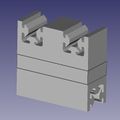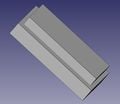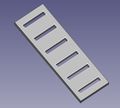
Dr. Parker within the ME-EM department at Michigan Tech University has had a need for components capable of adjusting the level at which the waves in the wave tank meet the wave gauges mounted above the water. Currently, a block is just being rotated between the intersecting cross members to raise all wave gauge levels at once, and they have no way to individually adjust the locations of each wave gauge. The solution posted here includes an interconnecting system to slide onto the 8020 where it intersects on each side of the wave tank, to use in order to be able to raise the cross member and all wave gauges mounted on it a specified level at once. The top and bottom blocks slide onto the 8020, where the middle block connects the top and bottom to add or remove height. As many middle blocks can be created as needed on each side for the desired height of the cross member. The individual adjuster attaches between the 8020 cross member that runs across the body of water and each individual wave gauge. The gauges are mounted through bolts, and when the adjuster is mounted between the gauges and the beam, the location of the gauge can be adjusted vertically between each of the slots on the adjuster. As many of these can be printed as necessary for as many wave gauges that are necessary for a test.
CAD Customization Capabilities[edit | edit source]
- The height of the middle block can be changed depending on the desired height adjustment for a test
- The length of the individual adjuster and the number of slots can also be adjusted depending on the desired height difference for a test
Project CAD Images[edit | edit source]
-
Blown apart assembly to show connections for the 8020 slides
-
Assembled parts for the 8020 slides
-
Bottom Slide Piece for mounting to single 8020 piece
-
Middle Block for Height Adjustment
-
Top slide piece for mounting to parallel pieces of 8020
-
Vertical adjustment bracket for individual wave gauges along cross member
Print Setup[edit | edit source]
- Models were created in FreeCAD with a 0.5 mm tolerance
- For use with a printer with a higher or lower resolution, the sketches within FreeCAD can be altered for a higher/lower tolerance
- For the prints, 1.75mm Hatchbox PLA was used with an AthenaII printer
- Settings in Cura: 0.15 mm layer height, 0.38 mm line width, 0.8 mm wall thickness, 25% infill density (grid pattern), 205 dC print temp, no build plate adhesion
- For the top slide: support was generated everywhere with a 50% overhang angle and zigzag support with a 20% density, and printed laying flat on the face with the 8020 shaped cuts as shown below. Support generates within the rectangular cut in this orientation.
- For the middle block: support was generated everywhere with a 50% overhang angle and zigzag support with a 20% density, and printed "upside down" with the extruded rectangular face touching the build plate as shown below. Support generates around the perimeter of the extruded rectangular face.
- For the bottom slide: support was generated everywhere with a 50% overhang angle and zigzag support with a 20% density, and printed laying flat on the face with the 8020 shaped cuts as shown below. Support generates between the bottom extrusion face and the plate.
- No support is necessary for the individual adjuster as long as it is printed on its largest flat surface as shown below.
-
Top Slide Print Orientation
-
Middle Block Print Orientation
-
Bottom Slide Print Orientation
-
Individual Adjuster Print Orientation
Cost Estimates[edit | edit source]
The following are the prices to print each component:
- Top slide: $0.92
- Middle block: $0.58
- Bottom slide: $0.90
- Individual adjuster: $0.50
Or a total of $4.80 for a functional set of blocks (x2 of each block, one set to raise each side of the cross member)
There is not necessarily a similar system made to serve the same purpose available online, so a custom set would have to be machined. The material required for these mounts using metal would need to be something with resistance to corrosion since it may come in contact with water such as Aluminum.
For 6061 Aluminum the prices are listed on McMaster as follows:
- Each individual adjuster would require 1x 1/4" thick, 2" wide, 6" long piece of aluminum found here for $3.10 each
- To make a fully functional set of blocks for use in the wave tank, it would require 2 of each block, which could be made from one piece of 1.5" thick, 1.5" wide, 24" long Aluminum found here for $35.52









